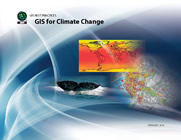ArcWatch: Your e-Magazine for GIS News, Views, and Insights
January 2011
A Systems Approach to Climate Change
GIS Gives Us Hope

Scientists should consider taking a geographic approach to studying climate change.
Geography is a fundamental science that helps us describe our planet's natural and human systems, including components that contribute to and are influenced by climate change. Geographic information system (GIS) technology gives you a comprehensive understanding of complex systems so that you can make informed decisions.
People use GIS every day to view and manage information about geographic features, analyze geographic relationships, and model geographic processes. As a foundational technology, it lets local, regional, and global organizations collect, manage, and analyze a myriad of physical, biological, and cultural data describing the Earth.
GIS is a simulation of the Earth with powerful tools that can assess future climatic conditions based on different management approaches. The result is power and flexibility, making it the system of choice for analyzing and managing Earth's complex systems.
A Proven System for Climate Change
GIS facilitates the geographic approach to making decisions, which is a new way of thinking and problem solving that integrates geographic information into how we understand and manage global issues that result from climate change. It's a systematic approach that allows us to "create" geographic knowledge by measuring the Earth, organizing this data and analyzing and modeling various processes and their relationships. It also allows us to apply this knowledge to the way we design, plan, and change our world.
GIS is an established technology with a long history of driving climate science and environmental decision making. Decision makers, policy makers, planners, scientists, and many others worldwide rely on GIS to address complex issues such as:
- Climate science and modeling
- Sustainable planning
- Renewable energy planning
- Rainforest management
- Carbon accounting and assessment
- Biomass and land-use inventory
- Reporting and compliance
- Disaster planning and management
- Real-time communication
- Community awareness and engagement
GIS users represent a vast reservoir of knowledge, expertise, and best practices in applying this cornerstone technology to the science of climate change and understanding its impact on natural and human systems.
Climate change is a geographic problem that needs a geographic system to solve it. A GIS-based framework for climate science gives us hope. With it we can gain a scientific understanding of Earth's complex systems at a truly global scale and make thoughtful, informed design decisions that ultimately allow humans and nature to coexist more harmoniously.
Jack Dangermond founded Esri with a vision that computer-based mapping and analysis could make significant contributions in geographic planning and environmental science.
[This article was reprinted from the book Climate Action 2010-2011. The book was published to coincide with the United Nations Climate Change Conference (COP), held last month in Cancun, Mexico. Climate Action is produced in partnership with the United Nations Environment Programme (UNEP) to encourage large and small businesses and organizations to reduce their carbon footprints and show that environmentally responsible operations can also be profitable.]
Further Reading
Climate Change is a Geographic Problem: The Geographic Approach to Climate Change
GIS for Climate Change: Case Studies in the Use of GIS for Climate Change


